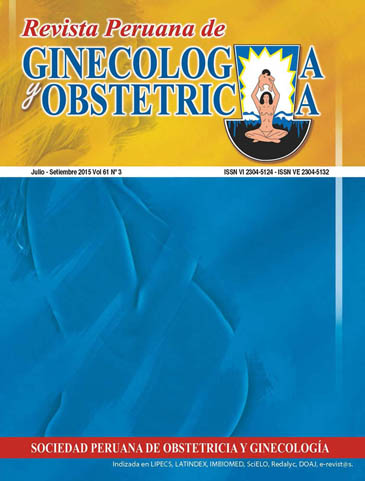Hemoglobina en recién nacidos por parto vaginal según clampaje precoz o tardío del cordón umbilical, a 2700 metros sobre el nivel del mar
DOI:
https://doi.org/10.31403/rpgo.v61i1849Resumen
Diversos estudios han demostrado que un clampaje tardío del cordón umbilical aumenta los niveles de hemoglobina de los recién nacidos. Objetivos: Evaluar si el clampaje tardío del cordón umbilical en neonatos a término muestra mayores valores de hemoglobina que cuando se realiza clampaje precoz, a 2700 msnm. Diseño: Investigación prospectiva, aleatorizada y doble ciego. Institución: Departamento de GinecoObstetricia, Hospital Regional de Cajamarca, Perú. Participantes: Recién nacidos y sus madres. Métodos: En enero de 2014, a 100 gestantes en trabajo de parto con gestación única, a término y sin otros factores de riesgo, se asignó al azar clampaje tardío (cuando dejó de latir el cordón umbilical 1 a 3 minutos) o clampaje precoz (alrededor de 10 segundos después del parto). Se midió el tiempo desde que aparecieron los hombros del bebé. Se procedió a sacar una muestra de sangre del talón derecho del recién nacido en 2 capilares y a las 6 horas de vida, y se analizó la hemoglobina, el hematocrito y grupo y factor Rh. Principales medidas de resultados: Nivel de hemoglobina. Resultados: Encontramos 91% de gestantes sin anemia y 9% con anemia; el grupo sanguíneo materno predominante fue el O+ en 86%. Se practicó clampaje tardío a 52 recién nacidos y clampaje precoz a 48. El 94% de los recién nacidos pesó entre 2 501 y 3 999 g, con Ápgar >7 en el 100%. El tiempo en que dejó de latir el cordón umbilical fue 2,67+-0,28 minutos. En 100% de los neonatos con clampaje temprano el valor de la hemoglobina fue <15 mg/dL y en el clampaje tardío el 71,1% presentó hemoglobina de 15,1 a 20,1 mg/dL, y 28,9% más de 20,1 mg/dL. No hubo diferencia significativa en los valores de hemoglobina de los recién nacidos sí la madre presentó o no anemia. Conclusiones: El clampaje tardío mostró mejores valores de hemoglobina en los neonatos. El tiempo medio en que dejó de latir el cordón fue 2,67 min y la anemia materna no influyó en la hemoglobina neonatal.Descargas
Descargas
Publicado
2015-11-12
Cómo citar
Tapia Correa, R. M., & Collantes Cubas, J. A. (2015). Hemoglobina en recién nacidos por parto vaginal según clampaje precoz o tardío del cordón umbilical, a 2700 metros sobre el nivel del mar. Revista Peruana De Ginecología Y Obstetricia, 61(3), 237–240. https://doi.org/10.31403/rpgo.v61i1849
Número
Sección
Artículos Originales
















